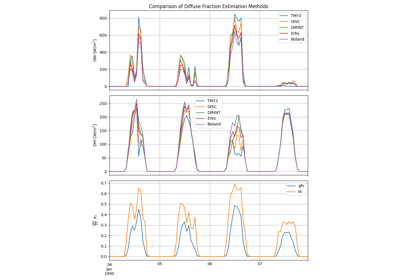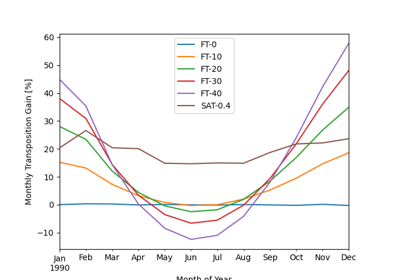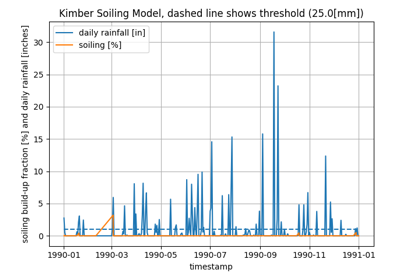pvlib.iotools.read_tmy3#
- pvlib.iotools.read_tmy3(filename, coerce_year=None, map_variables=None, recolumn=None, encoding=None)[source]#
Read a TMY3 file into a pandas dataframe.
Note that values contained in the metadata dictionary are unchanged from the TMY3 file (i.e. units are retained). In the case of any discrepancies between this documentation and the TMY3 User’s Manual 1, the TMY3 User’s Manual takes precedence.
The TMY3 files were updated in Jan. 2015. This function requires the use of the updated files.
- Parameters
filename (str) – A relative file path or absolute file path.
coerce_year (int, optional) – If supplied, the year of the index will be set to
coerce_year, except for the last index value which will be set to the next year so that the index increases monotonically.map_variables (bool, optional) – When True, renames columns of the DataFrame to pvlib variable names where applicable. See variable
VARIABLE_MAP.recolumn (bool (deprecated, use map_variables instead)) – If
True, apply standard names to TMY3 columns. Typically this results in stripping the units from the column name. Cannot be used in combination withmap_variables.encoding (str, optional) – Encoding of the file. For files that contain non-UTF8 characters it may be necessary to specify an alternative encoding, e.g., for SolarAnywhere TMY3 files the encoding should be ‘iso-8859-1’. Users may also consider using the ‘utf-8-sig’ encoding.
- Returns
Tuple of the form (data, metadata).
data (DataFrame) – A pandas dataframe with the columns described in the table below. For more detailed descriptions of each component, please consult the TMY3 User’s Manual 1, especially tables 1-1 through 1-6.
metadata (dict) – The site metadata available in the file.
Notes
The returned structures have the following fields.
key
format
description
altitude
Float
site elevation
latitude
Float
site latitudeitude
longitude
Float
site longitudeitude
Name
String
site name
State
String
state
TZ
Float
UTC offset
USAF
Int
USAF identifier
field
description
† denotes variables that are mapped when `map_variables` is True
Index
A pandas datetime index. NOTE, the index is timezone aware, and times are set to local standard time (daylight savings is not included)
ghi_extra†
Extraterrestrial horizontal radiation recv’d during 60 minutes prior to timestamp, Wh/m^2
dni_extra†
Extraterrestrial normal radiation recv’d during 60 minutes prior to timestamp, Wh/m^2
ghi†
Direct and diffuse horizontal radiation recv’d during 60 minutes prior to timestamp, Wh/m^2
GHI source
See 1, Table 1-4
GHI uncert (%)
Uncertainty based on random and bias error estimates see 2
dni†
Amount of direct normal radiation (modeled) recv’d during 60 mintues prior to timestamp, Wh/m^2
DNI source
See 1, Table 1-4
DNI uncert (%)
Uncertainty based on random and bias error estimates see 2
dhi†
Amount of diffuse horizontal radiation recv’d during 60 minutes prior to timestamp, Wh/m^2
DHI source
See 1, Table 1-4
DHI uncert (%)
Uncertainty based on random and bias error estimates see 2
GH illum (lx)
Avg. total horizontal illuminance recv’d during the 60 minutes prior to timestamp, lx
GH illum source
See 1, Table 1-4
GH illum uncert (%)
Uncertainty based on random and bias error estimates see 2
DN illum (lx)
Avg. direct normal illuminance recv’d during the 60 minutes prior to timestamp, lx
DN illum source
See 1, Table 1-4
DN illum uncert (%)
Uncertainty based on random and bias error estimates see 2
DH illum (lx)
Avg. horizontal diffuse illuminance recv’d during the 60 minutes prior to timestamp, lx
DH illum source
See 1, Table 1-4
DH illum uncert (%)
Uncertainty based on random and bias error estimates see 2
Zenith lum (cd/m^2)
Avg. luminance at the sky’s zenith during the 60 minutes prior to timestamp, cd/m^2
Zenith lum source
See 1, Table 1-4
Zenith lum uncert (%)
Uncertainty based on random and bias error estimates see 1 section 2.10
TotCld (tenths)
Amount of sky dome covered by clouds or obscuring phenonema at time stamp, tenths of sky
TotCld source
See 1, Table 1-5
TotCld uncert (code)
See 1, Table 1-6
OpqCld (tenths)
Amount of sky dome covered by clouds or obscuring phenonema that prevent observing the sky at time stamp, tenths of sky
OpqCld source
See 1, Table 1-5
OpqCld uncert (code)
See 1, Table 1-6
temp_air†
Dry bulb temperature at the time indicated, deg C
Dry-bulb source
See 1, Table 1-5
Dry-bulb uncert (code)
See 1, Table 1-6
temp_dew†
Dew-point temperature at the time indicated, deg C
Dew-point source
See 1, Table 1-5
Dew-point uncert (code)
See 1, Table 1-6
relative_humidity†
Relatitudeive humidity at the time indicated, percent
RHum source
See 1, Table 1-5
RHum uncert (code)
See 1, Table 1-6
pressure†
Station pressure at the time indicated, 1 mbar
Pressure source
See 1, Table 1-5
Pressure uncert (code)
See 1, Table 1-6
wind_direction†
Wind direction at time indicated, degrees from north (360 = north; 0 = undefined,calm)
Wdir source
See 1, Table 1-5
Wdir uncert (code)
See 1, Table 1-6
wind_speed†
Wind speed at the time indicated, meter/second
Wspd source
See 1, Table 1-5
Wspd uncert (code)
See 1, Table 1-6
Hvis (m)
Distance to discernable remote objects at time indicated (7777=unlimited), meter
Hvis source
See 1, Table 1-5
Hvis uncert (coe)
See 1, Table 1-6
CeilHgt (m)
Height of cloud base above local terrain (7777=unlimited), meter
CeilHgt source
See 1, Table 1-5
CeilHgt uncert (code)
See 1, Table 1-6
precipitable_water†
Total precipitable water contained in a column of unit cross section from earth to top of atmosphere, cm
Pwat source
See 1, Table 1-5
Pwat uncert (code)
See 1, Table 1-6
AOD
The broadband aerosol optical depth per unit of air mass due to extinction by aerosol component of atmosphere, unitless
AOD source
See 1, Table 1-5
AOD uncert (code)
See 1, Table 1-6
albedo†
The ratio of reflected solar irradiance to global horizontal irradiance, unitless
Alb source
See 1, Table 1-5
Alb uncert (code)
See 1, Table 1-6
Lprecip depth (mm)
The amount of liquid precipitation observed at indicated time for the period indicated in the liquid precipitation quantity field, millimeter
Lprecip quantity (hr)
The period of accumulatitudeion for the liquid precipitation depth field, hour
Lprecip source
See 1, Table 1-5
Lprecip uncert (code)
See 1, Table 1-6
PresWth (METAR code)
Present weather code, see 2.
PresWth source
Present weather code source, see 2.
PresWth uncert (code)
Present weather code uncertainty, see 2.
Midnight representation
The function is able to handle midnight represented as 24:00 (NREL TMY3 format, see 1) and as 00:00 (SolarAnywhere TMY3 format, see 3).
Warning
TMY3 irradiance data corresponds to the previous hour, so the first index is 1AM, corresponding to the irradiance from midnight to 1AM, and the last index is midnight of the next year. For example, if the last index in the TMY3 file was 1988-12-31 24:00:00 this becomes 1989-01-01 00:00:00 after calling
read_tmy3().Warning
When coercing the year, the last index in the dataframe will become midnight of the next year. For example, if the last index in the TMY3 was 1988-12-31 24:00:00, and year is coerced to 1990 then this becomes 1991-01-01 00:00:00.
References
- 1(1,2,3,4,5,6,7,8,9,10,11,12,13,14,15,16,17,18,19,20,21,22,23,24,25,26,27,28,29,30,31,32,33,34,35,36,37,38,39)
Wilcox, S and Marion, W. “Users Manual for TMY3 Data Sets”. NREL/TP-581-43156, Revised May 2008. DOI: 10.2172/928611
- 2(1,2,3,4,5,6,7,8,9)
Wilcox, S. (2007). National Solar Radiation Database 1991 2005 Update: Users Manual. 472 pp.; NREL Report No. TP-581-41364. DOI: 10.2172/901864
- 3
Examples using pvlib.iotools.read_tmy3#
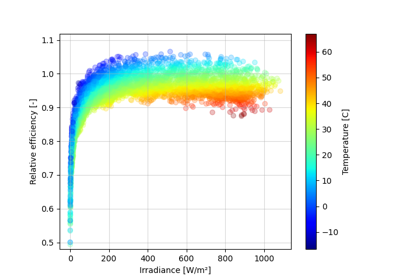
Simulating PV system DC output using the ADR module efficiency model
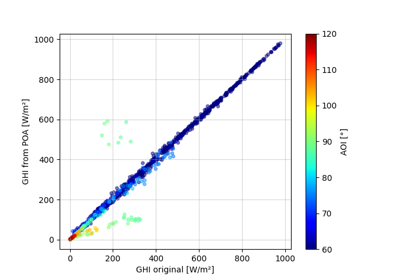
Reverse transposition using one year of hourly data
